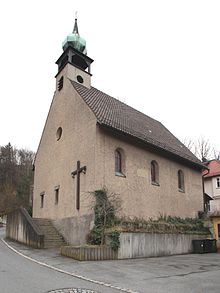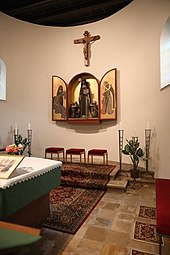St. Ottilia (Neustadt near Coburg)
The Roman Catholic Church of St. Ottilia in Neustadt bei Coburg was consecrated in 1930 and is a listed building .
history
In 1907 there were around 100 Catholics in Neustadt who attended church services in the parish of St. Stefan in Sonneberg . On June 25, 1922, Holy Mass was celebrated in the city for the first time since the Reformation . This took place in a canteen redesigned into a chapel in Plant III of the Max Oscar Arnold factory. Due to the industrial development of Neustadt, around 200 people who professed their Catholic faith lived in the city at that time.
The pastoral care of the faithful was initially the responsibility of St. Augustin in Coburg. In 1925 it was transferred to the nearby Sonneberg parish of St. Stefan. On November 21, 1925, the Coburg church administration acquired the Villa Rosalie at Gabelsbergerstraße 2, which was used as a parsonage and the attached workshop as a prayer room. In the years that followed, the church administration sought to build a small church in the garden of the property for the diaspora community . With the help of a state collection approved by the Bavarian Minister of Culture and the receipt of a preferential donation from the Bonifatiusverein , the financial means of 44,000 RM required for the construction were secured.
The Munich architect Georg Holzbauer was responsible for planning the church building. The groundbreaking ceremony was on July 14, 1930 and the foundation stone was laid on July 27. The ceremonial consecration was carried out by the Archbishop of Bamberg, Johann Jakob von Hauck, on October 11th and 12th. In memory of an earlier pilgrimage site, the Ottilien Chapel on the neighboring Muppberg , the church of St. Ottilia was consecrated.
In 1933, an independent subsidiary church with a total of 294 members (including the surrounding parishes) was set up in Neustadt. The congregation, which had 300 members in 1939, was looked after by chaplains from Sonneberg until 1945, with the exception of the years from 1936 to early 1942. This ended the inner-German border between Neustadt and Sonneberg.
After the Second World War , the number of parish members grew to over 1,500 due to the displaced persons. At the beginning of 1946, the daughter parish was raised to an independently administered local chaplaincy with its own clergy. On 25 October 1956, the Archbishop of Bamberg rose Josef Schneider finally Kaplanei Neustadt to the parish and appointed the competent since 1952 Kaplan Oskar Probst for the first pastor. After the Reformation it was the second independent parish in the area of the former Duchy of Saxony-Coburg . At the end of the 1960s, the sanctuary was redesigned in accordance with the provisions of the 2nd Vatican Council. An increase in the number of parishioners to almost 2000 led to the construction of a new, much larger parish church on the Am Moos site in the early 1970s, based on plans by the Coburg architect Josef Rauschen. The new parish church of the Transfiguration of Christ was consecrated on July 18, 1971.
Building description
St. Ottilia stands on a slope and is accessible by stairs due to the height differences in the terrain. A small church square was created at the main entrance on the east side. The church is a south-facing, plastered hall building that is spanned by a wooden beam ceiling. A small gallery is located on the north side. A triumphal arch connects the nave with a semicircular retracted choir . A gable roof with a gable turret and an onion turret forms the upper end . To the east of the choir is the sacristy with a basement . The nave initially had 126 seats.
The carved, painted and gilded high altar is designed as a winged altar and shows scenes from the legend of St. Ottilia, which is depicted as a half-relief. A blind family kneels at their feet. On the right wing there is a bishop baptizing the blind Ottilia and on the left wing Saint Ottilia helping a woman who has recently given birth with her child. The altar is the work of the Munich artist Hans Panzer. The two bells come from Weyarn Abbey and were cast in the 17th century. Since 1935, two stained glass windows with representations of the Bamberg bishops Otto and Heinrich II and, since 1952, Stations of the Cross have adorned the interior. In 1966/67 the pulpit on the left side of the triumphal arch was removed and replaced by an old wooden Madonna. The tabernacle was moved from the main altar to the side altar and let into the wall there.
For church music there was a harmonium , which was replaced by an electric organ in 1989.
Web links
Individual evidence
- ↑ a b c Helmut Scheuerich: History of the city of Neustadt near Coburg in the twentieth century , second volume, 1993, p. 518f.
- ^ Lothar Hofmann: Monuments Region Coburg - Neustadt - Sonneberg: Places of contemplation and prayer. Historical sacred buildings. A guide through the churches in the districts of Coburg and Sonneberg . Verlag Gerätemuseum des Coburger Land, Ahorn 2007, ISBN 3-930531-04-6 , p. 69.
Coordinates: 50 ° 19 ′ 32.9 ″ N , 11 ° 7 ′ 39.2 ″ E


